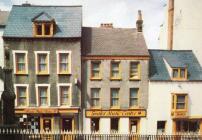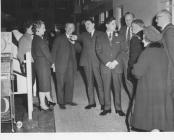Content can be downloaded for non-commercial purposes, such as for personal use or in educational resources.
For commercial purposes please contact the copyright holder directly.
Read more about the The Creative Archive Licence.
Description
Dedication: Unknown
Denomination: Anglican
Built: 12th/13th century with later additions
Restored: 1887 Photography: Steve Veysey
Date: 3 October 2009
Camera:, Canon PowerShot SX110 IS digital
Note 1.
Fill your lungs with Penallt air, the air that makes children dance and old men sing. Then inspect the mighty yew, the base and stump of the churchyard cross, the sundial on the porch, and the saddle-back tower. Within that tower are four bells, three made at Chepstow in 1740 and 1751, the fourth, when Sir George Probert was a churchwarden, in 1662. They are inscribed with the initials of the church-wardens and bell-founders (Evans of Chepstow and Palmer of Gloucester).
The date, 1539, on the church door is the date when the door was fixed, but the church is at least three centuries older. Of the three-decker pulpit with its reading desk and clerk's seat only the pulpit remains; the oak communion rails are dated 1743; steps to the rood loft, an oak coffer five feet nine inches long, the wagon-roof, Queen Anne's coat of arms over the chancel, and the extraordinary passage from the south aisle into the chancel will engage your attention, and although pews replace the old box seating you will agree that St. Mary's, Penallt, wears the loveliness of a serene old age.
The altar was carved by the chief wood-carver of Malines cathedral, who was a Belgian refugee during the 1914-18 war. It is a copy of a stone altar at Ravenna.
[Source: Out and About in Monmouthshire, by Fred J. Hando, R. H. Johns Ltd., Newport, 1958]
Note 2.
The whole interior of the church suffered a 'restoration' in 1887, and a great deal of historical interest was probably destroyed. The galleries along the north wall of the nave and at the west end — which must have made the church very dark — were removed, as were the old oaken box pews, which gave place to low backed pitch-pine seats. At this time, too, the floor of the nave was sloped down to the chancel to eliminate the step which previously existed. But much of great interest remains. The lower range of steps, leading to an old rood loft can still be seen at the north-west of the chancel, though the mediaeval rood-screen no longer exists. The present pulpit is the top section of a Jacobean 'three decker'; the oak altar rail dates from 1753. And the most ancient piece of church furniture is a massive dug-out muniment chest, carved from one solid oak trunk, dating probably from the 12th century. The stone slab altar in the south aisle, probably the original pre-Reformation altar of the church, was retrieved from the ground outside the porch in 1965, The stone font was carved from an ancient design, by Mrs Probert, who also carved from a holly bole, the figure of the Virgin which stands above the north-east corner of the nave, and which was painted in mediaeval colours by her husband, Major Y R H Probert. He and other parishioners also painted the bosses in the nave. There are modern commemorative roof bosses in the south aisle. [Source: Penallt Village Website, where many more details and photographs are available]
Image 2:
Sketch by Fred Hando in Out and About in Monmouthshire, by Fred J. Hando, R. H. Johns Ltd., Newport, 1958
Note 3.
The nave north wall is 12th or 13th century and the saddleback roofed west tower is 14th century. The north windows, chancel, south aisle with four narrow arches on complex moulded piers and a squint to the chancel, and the south porch are all good 15th century work. Of that period also are the fine wagon roofs. The chancel arch is offset to the south allowing room for a doorway to the former rood-loft from steps along the chancel north wall. There is an old chest. The main door dates from 1539 and has a heart on it. The only later features are a chancel north window, the three heavy buttresses against the nave north wall, and the Jacobean pulpit with pilasters, arches, etc. [Source: The Old Parish Churches of Gwent, Glamorgan & Gower, by Mike Salter, Folly Publications, Malvern, 1991; ISBN 1-871731-0809]
Image 3:
Sketch by Norman Keeney in A History of Monmouthshire Volume 2 Part 2 The Hundred of Trelech by Sir Joseph Bradney, Mitchell Hughes & Clarke, London, 1913
Note 4.
The situation of the church above the River Wye, 400 feet above sea level, makes it a conspicuous object. It stands on a bank sloping eastwards, in which direction the floor has a gradual fall. Up to the year 1886 the edifice retained the features of the seventeenth century, with a large gallery on the north and west sides of the nave, high oak pews, an oak pulpit, reading desk, and clerk's pew, of which only the pulpit has been spared to remain. The communion rails are of oak, with the lettering I R CW 1743 [Source: A History of Monmouthshire Volume 2 Part 2 The Hundred of Trelech, by Sir Joseph Bradney, Mitchell Hughes & Clarke, London, 1913]










Do you have information to add to this item? Please leave a comment
Comments (0)
You must be logged in to leave a comment